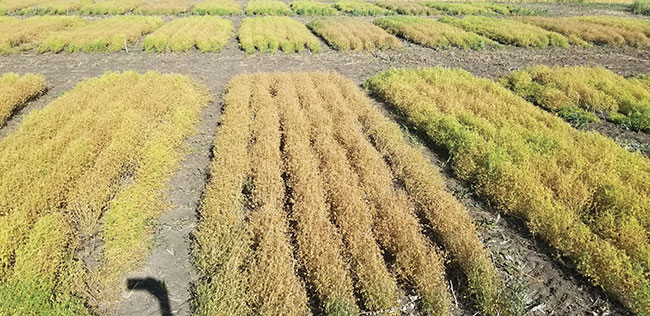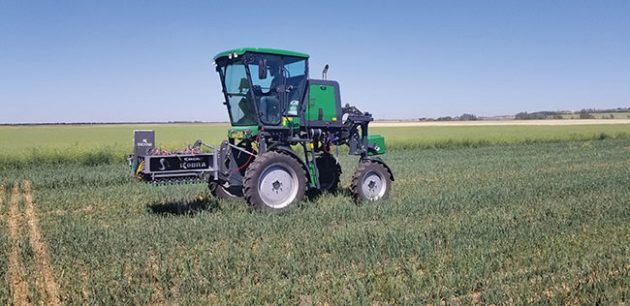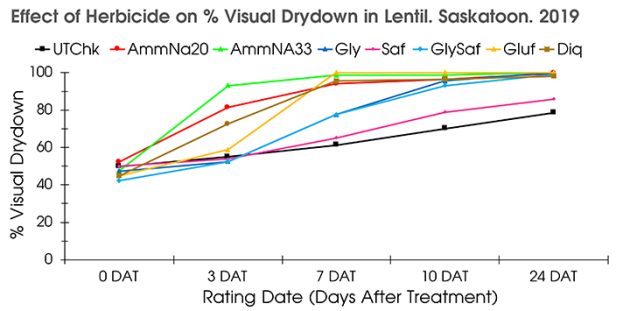
Features
Desiccants
Pulses
Investigating a new lentil desiccant
Ammonium nonanoate shows potential.
January 23, 2022 By Bruce Barker
 Ammonium nonanoate (centre) three hours after
application compared to the un-treated control (right).
Photo courtesy of Eric Johnson.
Ammonium nonanoate (centre) three hours after
application compared to the un-treated control (right).
Photo courtesy of Eric Johnson. Desiccation is an important management tool for lentil growers, but some desiccants are under scrutiny by consumers and lentil buyers. As a result, researchers at the University of Saskatchewan are looking for alternatives.
“There are consumer concerns in terms of pesticide residues in our food, and for various reasons, glyphosate has been targeted,” says Eric Johnson, research officer in the department of plant sciences at the University of Saskatchewan’s College of Agriculture and Bioresources. “This has led to some lentil buyers specifying in their contracts that pre-harvest glyphosate cannot be applied.”
Additionally, glufosinate is not recommended for preharvest use in lentil even though it is registered. This is because some importing countries have lower MRL’s than Canada, so buyers are reluctant to purchase lentils treated with pre-harvest glufosinate.
In 2019 and 2020, Johnson and collaborators Shaun Campbell, Sydney Redekop, Keshava Singh and Steve Shirtliffe investigated the potential of ammonium nonanoate as a lentil desiccant. Ammonium nonanoate is a mixture of ammonia and pelargonic (nonanoic) acid. It is a nine-carbon fatty acid, giving it the name nonanoic. It is a non-systemic, broad spectrum contact herbicide with no soil activity. It is sold under the trade name Axxe in North America.
In Canada, Axxe is registered for pre-seed burndown, spot application or shielded inter-row application in field crops, pastures and non-crop areas. A 13.5 per cent concentration solution is recommended; the concentration varies depending on weed size.
In the U.S., Axxe is registered as a desiccant in potato and cotton. Desiccation rates for potato are 20 to 32.5 per cent concentration using a 17.8 imperial gallon per acre (200 L/ha) carrier volume, and the rate is dependent on foliage density.
Axxe is organic approved under OMRI, however its use is quite restricted with only farmstead maintenance and application to ornamental crops as approved uses.
Johnson compared Axxe to several registered lentil desiccants in Saskatoon. The eight treatments included an untreated check, Axxe at 20 per cent and 33 per cent concentrations, glyphosate at 900 grams of active ingredient per hectare (g ai/ha), saflufenacil (heat) at 36 g ai/ha, a tank mix of glyphosate and saflufenacil (900 + 36 g ai), glufosinate at 400 g ai/ha, and diquat at 296 g ai/ha. These were recommended label rates for desiccation, and adjuvants were also applied as required.
The desiccants were applied in 200 L per hectare with medium spray quality nozzles to CDC Maxim small red lentil. In 2019, the desiccants were applied with a backpack sprayer. In 2020, they were applied with the university’s new Kincaid Kobra sprayer that was mounted on a Zurn 550 tool carrier. This unit has 16 booms, so up to 16 products can be applied based on plot maps.
Target application timing was when the lowermost pods were brown and rattled when shaken. However, Johnson says the timing was a bit early in 2019 and a bit late in 2020 due to differing weather conditions. Application dates were Aug. 20, 2019, and Aug. 10, 2020. Weather conditions in 2019 were quite wet in August and September, but terminal drought occurred in July and August in 2020.

A Kincaid Kobra sprayer was used to compare desiccants in lentil.
Photo courtesy of Eric Johnson.
Visual drydown ratings were conducted at three, seven, 10 and 24 days after treatment.
“We found that Axxe works very quickly. Three hours after application, significant necrosis had occurred,” Johnson says.
The visual drydown ratings at 24 days after treatment illustrate how quickly Axxe acted as a desiccant compared to the other herbicides. For example, in 2019, Axxe 20 per cent concentration achieved about 80 per cent drydown after three days, rising to about 90 per cent after seven days. Axxe 33 per cent concentration achieved 90 per cent drydown after three days.
By comparison, glyphosate alone reached 90 per cent drydown after 10 days, and saflufenacil only achieved 80 per cent drydown after 24 days. The glyphosate plus saflufenacil tank-mix achieved similar results as glyphosate alone. Glufosinate achieved 90 per cent drydown seven days after treatment, as did diquat, but diquat was slightly faster at three days after treatment.
Effect of Herbicide on % Visual Drydown in Lentil [Saskatoon, 2019].
In 2020, trends were similar for most herbicides. The two concentrations of Axxe resulted in similar results with about 90 per cent dry down after three days. The glyphosate plus saflufenacil treatment worked slightly better in 2020 with the tank-mix reaching 90 per cent dry down seven to 10 days after application. Diquat also reached 90 per cent drydown seven to 10 days after treatment.
Desiccation treatments had no effect on yield in 2019 or 2020.

Source: Johnson et al. 2020.
Crop imagery showing potential for assessing drydown
In the department of plant sciences’ Crop Imaging Lab, Johnson says post-doctoral fellow Keshav Singh worked on using digital imagery for phenotyping, and part of that work involved quantifying herbicide efficacy and phytotoxicity. In this study, he quantified desiccation drydown using hyperspectral imagery.
The crop imaging project uses a drone with a Corning microHSI camera to take images at the same time as visual ratings. For example, in 2019, three days after application the spectral profiles of three treatments differed from the untreated check in the red edge to near infrared regions, indicating a faster drydown. These were diquat and the two rates of Axxe. This correlated to the visual assessments.
Singh also used a number of different vegetative indexes derived from the spectral data to evaluate their relationships with visual ratings. He found a maturity index correlated strongly with visual ratings.
“The results from 2019 indicate that hyperspectral imagery may have the potential to be used as a means of objectively quantifying plant drydown from desiccant application,” Johnson says.
Overall, ammonium nonanoate was effective in desiccating lentil plant material, and Johnson notes it worked very quickly – even a little bit quicker than diquat, but quite similar. However, he notes it is not cost effective at the current price and rate structure. At the rates used and the retail price, the cost would be more than $300 per acre.
“Axxe still worked quite well at the 20 per cent concentration, so there may be potential to use lower rates, but much lower rates would be required to become economical,” Johnson notes. “We also haven’t looked at the effect of Axxe herbicide on the grade of the lentil, so that would have to be investigated in further studies, as well.”
Further research was not conducted in 2021, but Singh, now at Agriculture and Agri-Food Canada in Lethbridge, has applied for funding to carry on the research in the future.